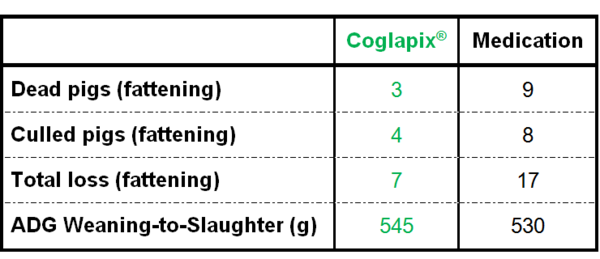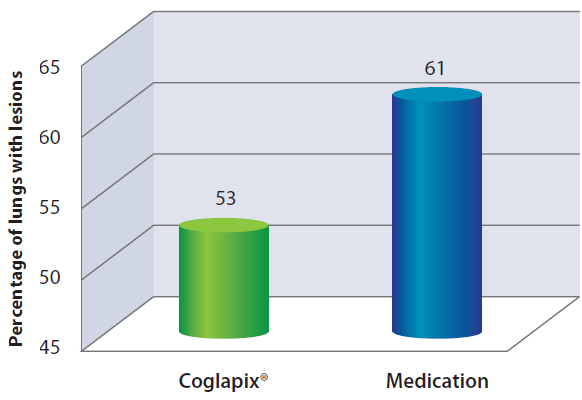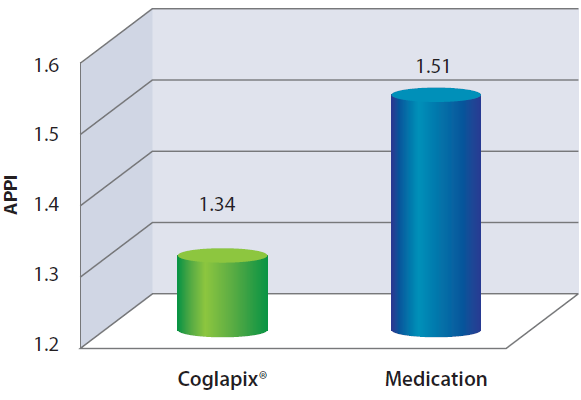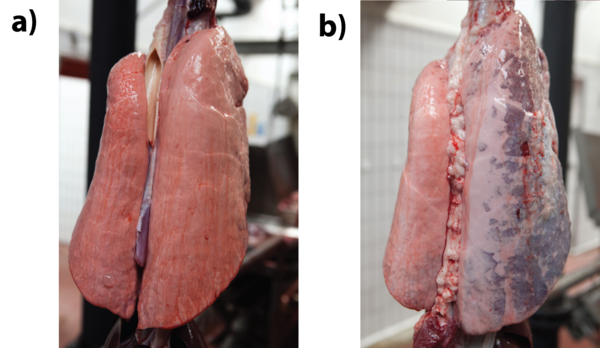.
.
-->Introduction
-->Results
-->Conclusions
.
.
COMPARISON OF VACCINATION WITH COGLAPIX® AND TARGETED MEDICATION IN THE PREVENTION OF PLEUROPNEUMONIA IN PIGS
ByKrejci R.1, Révész T.2
1Ceva, Libourne, France;
2Ceva Phylaxia, Budapest, Hungary.
.
Introduction
Actinobacillus pleuropneumoniae (A.p) continues to be an economically important pathogen causing pleuropneumonia in pigs throughout the world. It can appear as a singular disease, or more frequently as an important part of porcine respiratory disease complex (PRDC). Porcine pleuropneumonia results in substantial production losses including high mortality and reduced growth rate in growing and fattening pigs. Even herds with subclinical forms of the disease can be seriously affected with substantial overall losses due to lower growth performance, feed efficiency and additional medication cost.
Antibiotics are frequently used for the mass repeated medication in growing and finishing phase to control pleuropneumonia. Current trend in pig farming is to reduce the overall use of antibiotics, particularly in the oral forms.
The aim of this study was to evaluate the impact of vaccination on health and economic balance in comparison with the targeted medication against A.p.
.
Materials and methods
In total 541 weaned piglets in farm with endemic pleuropneumonia problems were randomly assigned in two equal groups G1 and G2.
G1 pigs were vaccinated with Coglapix® at 7 and 10 weeks of age (W).
G2 pigs were medicated with florphenicol (200pm) and amoxicillin (20mg/kg lbw) for 6 days at 12W and 14W.
Standard prophylactic medication with colistin (post-weaning) and tiamulin with CTC (prevention of dysentery at 15W) practiced in the farm, remained unchanged for both groups.
Total loss in the fattening period and average daily gain in the whole weaning-to-slaughter period (ADG) was measured. Pigs were examined at slaughter (100 pigs per group) for lung lesions according to SPES method, which is suggestive for previous A.p induced pleuropneumonia1. APPI index was calculated to evaluate the incidence and extension of dorso-caudal pleurisy.
.
Results
The overall performance improved in the G1 compared to G2. The total loss in the fattening phase of G1 represented 41% of the total loss in G2 and the ADG within the weaning-slaughter time was 15 grams higher in G1 (Figure 1).
Figure 1 Performance indicators of G1 and G2
The lung scoring showed differences in the incidence (Figure 2) of dorso-caudal pleurisy as well as in the extension of those lesions (Figure 3).
Figure 2 Incidence of A.p-like lesions in slaughter pigs
Figure 3 APPI index of A.p-like lesions in slaughter pigs
Figure 4 Healthy lungs (a) and monolateral extended dorso-caudal pleurisy typical for previous A.p infection (b)
The cost of prevention of pleuropneumonia was 2.58€ less in G1 than in G2 (Figure 5).
Figure 5 Cost of vaccination and medication per pig
.
Conclusions
Vaccination with Coglapix® appeared more efficient against the A.p infection than the targeted medication in terms of protection of health and performance. It was also less expensive. Prevention through vaccination is also perfectly in line with the current trends of responsible use of antibiotics.
.
Bibliography
1Dottori M., et al 2007
.
(Source: Axis Issue 02 / Sept 2013 - Ceva Asia Pacific - Proceedings APVS 2013)
.
Related topics: a.p coglapix antibiotic actinobacillus pleuropneumoniae

 Corporate Website
Corporate Website
 Africa
Africa
 Argentina
Argentina
 Asia
Asia
 Australia
Australia
 Belgium
Belgium
 Brazil
Brazil
 Bulgaria
Bulgaria
 Canada (EN)
Canada (EN)
 Chile
Chile
 China
China
 Colombia
Colombia
 Denmark
Denmark
 Egypt
Egypt
 France
France
 Germany
Germany
 Greece
Greece
 Hungary
Hungary
 Indonesia
Indonesia
 Italia
Italia
 India
India
 Japan
Japan
 Korea
Korea
 Malaysia
Malaysia
 Mexico
Mexico
 Middle East
Middle East
 Netherlands
Netherlands
 Peru
Peru
 Philippines
Philippines
 Poland
Poland
 Portugal
Portugal
 Romania
Romania
 Russia
Russia
 South Africa
South Africa
 Spain
Spain
 Sweden
Sweden
 Thailand
Thailand
 Tunisia
Tunisia
 Turkey
Turkey
 Ukraine
Ukraine
 United Kingdom
United Kingdom
 USA
USA
 Vietnam
Vietnam








